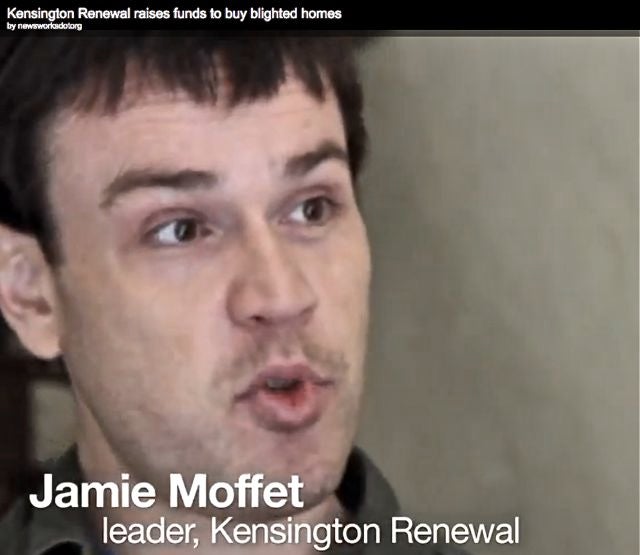Kensington community activist hopes to become a one-man CDC
It sounds so simple: Raise money to buy vacant homes, enlist a small crew of volunteers to fix them up and sell them at reasonable prices to responsible long-term renters.
Then, take these residents ― now empowered by home ownership ― and work with them to fight the blight and crime plaguing the neighborhood.
In a sense, it’s straight out of a page of Urban Redevelopment 101 and it’s what community activist and documentary filmmaker Jamie Moffett is trying to do in Kensington.
Through a new website he set up a few weeks ago, Moffett is attempting to raise $10,000 ― a goal he says he’s close to meeting.
He wants to use the money to buy an abandoned house ― currently occupied, he says, by a squatter ― around the corner from his production studio, located a few blocks from Kensington and Allegheny avenues.
In recent months, Moffett has started a low-level campaign against the drug dealers on his block ― several of whom could be seen on a stoop, waiting for customers, on a recent trip to the block.
He’s worked to improve lighting and to fence off alleyways where addicts go to shoot up.
“I need more allies,” he says of the housing effort, which he’s calling Kensington Renewal, pointing to studies that show high rates of home ownership go hand-in-hand with lower crime rates.
Moffett calls that “the statistic that I fell in love with.”
But though the idea seems simple ― and no one doubts Moffett’s good intentions ― people active in the city’s community development efforts say actually pulling this plan off will be difficult.
“He really would have to prove” his concept works before he gets major support from the city and community development corporations, says Laura Semmelroth of New Kensington Community Development Corporation, which is active in the neighborhoods to the east of Moffett’s studio.
At the same time, Semmelroth says that “he’s been in the room with the right people” and that CDCs such as hers have had difficulty doing the type of small-scale, infill development that Moffett is trying to pull off.
And for Moffett, that’s the whole point: The city and established community organizations have failed to tackle the big problem he thinks is facing Kensington.
Unlike, say, Strawberry Mansion, Kensington still has a relatively high occupancy rate. Burned-out and abandoned houses exist side-by-side with occupied dwellings, meaning the city’s preferred method of redevelopment ― acquiring and clearing entire blocks to build entirely new houses on ― won’t work.
Instead, Moffett thinks that rehabbing a few key properties could turn the neighborhood around.
Moffett’s interest in vacant land policy “literally started in my backyard.” He was trying to get in touch with the owner of a vacant property directly behind his production studio, which he bought and rehabbed in 2007.
The owner of that property turned out to be Robert Coyle, a Port Richmond developer who is now facing federal fraud charges over the handling of his real estate portfolio, which at one point numbered over 300 properties.
And after Coyle’s real estate empire collapsed when the economy tanked, Moffett saw that the city’s mechanisms for dealing with blight weren’t having any effect ― the property continued to decay, even after a new owner bought it in 2010. Moffett finally ended up building a large concrete wall in his backyard to seal it off.
“How does a house just get stuck” like that, Moffett asks.
He next tried to take over a nearby vacant lot using the state’s new conservatorship law, which allows community groups or neighbors to gain control over properties without having to actually get title over them.
But the process proved too cumbersome, Moffett said, and he didn’t have the legal expertise or the money needed to actually get a judge to approve a takeover.
“I’m not a non-profit,” he says.
So Moffett finally turned to his current scheme.
“I just want to straight-up buy it,” he explains.
Once that’s accomplished, Moffett plans on recruiting a small group of what he calls his “fellow crazies” ― who are willing to lend their time to rehab the house on the cheap.
Then he wants to identify a longtime renter in the neighborhood and sell him the house. Moffett’s even willing to provide a prospective owner with a private mortgage out of his own savings if banks won’t underwrite the loan.
Actually pulling this off will be difficult.
Though the city has a relatively good model for pulling off large-scale low-income housing developments ― think of the work Asociación Puertorriqueños en Marcha is doing in North Philadelphia ― it’s harder to do infill development of the kind Moffett is planning.
Though some smaller programs, like the city’s Homeownership Rehabilitation Program, target infill development, federal subsidies, which provide much of the money for low-income housing efforts, are increasingly targeted toward large-scale developments, says Don Hinkle-Brown, CEO of The Reinvestment Fund, a nonprofit that focuses on redevelopment assistance.
HOPE III, a federal program geared toward funding the rehabilitation of individual homes, ran out of money in the 1990s. Federal housing efforts are now focused on developing large tracts of land to replace crumbling high rises, something the Philadelphia Housing Authority specialized in under disgraced former executive director Carl Greene.
“It’s an often-overlooked activity,” Hinkle-Brown says of infill-housing projects. And because it’s difficult to get a mortgage for under $50,000 ― which is a bit above the average house price in Moffett’s neighborhood ― such governmental support is all the more crucial to stimulate development.
Even the Neighborhood Stabilization Program, the Philadelphia Redevelopment Authority’s much-touted effort to combat foreclosures, isn’t designed to do what Moffett is trying.
Though it targets individual properties ― operating under the principle that saving key properties can halt the advance of blight ― it’s limited to specific census tracts that don’t include Kensington.
And, with certain exceptions, it’s designed to be a foreclosure-mitigation program, paying for renovations to properties that had been occupied until foreclosure forced owners out.
It doesn’t target long-abandoned properties like the kind that exist in Moffett’s neighborhood, says city spokesman Paul Chrystie.
Impact Services, the CDC which operates in Moffett’s neighborhood, serves as a case in point in the trend toward large-scale redevelopment projects.
Though it tried infill projects in the past, the organization says those ran into problems. It’s now focused on building a 59-unit apartment complex on the site of a burned-down factory at Westmoreland and H streets.
But for Moffett, that piece of land, which has sat vacant for years as Impact tries to win federal Housing and Urban Development money for the project, is emblematic of the problems in the city’s development strategy.
“We need to fix the holes in our system” of streets, not spend years chasing money for large-scale projects, he argues.
As evidence that his approach, avoiding the bureaucratic red tape of HUD regulations and the city’s vacant property policies, is the right one, he points to a community garden he helped plant across the street from that vacant lot.
He contrasts the neatly trimmed grass and tended raised beds of his garden with the dirt and debris covering the site of the proposed senior development.
And Moffett says that he’s only weeks away from purchasing his first property.
But sparking community rehabilitation is a lot more difficult than creating a community garden ― or even buying a house. And only time will tell whether Moffett is starting something that will end up being a model for a new generation of community activists seeking to revitalize their neighborhoods.
Contatct the reporter at acampisi@planphilly.com
WHYY is your source for fact-based, in-depth journalism and information. As a nonprofit organization, we rely on financial support from readers like you. Please give today.





















